Holy Roman Emperor
| Emperor of the Holy Roman Empire | |
|---|---|
| Romanorum Imperator | |
Imperial | |
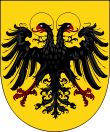 Double-headed Reichsadler used by the Habsburg emperors of the early modern period | |
 Last to reign Francis II 5 July 1792 – 6 August 1806 | |
| Details | |
| Style | His Imperial Majesty |
| First monarch | Charlemagne/Otto the Great |
| Last monarch | Francis II |
| Formation | 25 December 800/2 February 962 |
| Abolition | 6 August 1806 |
| Appointer | see Coronation of the Holy Roman Emperor |
The Holy Roman Emperor (historically Romanorum Imperator, "Emperor of the Romans") was the ruler of the Holy Roman Empire (800/962-1806 AD, from Charlemagne/Otto I to Francis II). The title was, almost without interruption, held in conjunction with the rule of the Kingdom of Germany.[1][2][3]
From an autocracy in Carolingian times the title evolved into an elected monarchy chosen by the prince-electors. The Holy Roman Emperor was widely perceived to rule by divine right, though he often contradicted or rivaled the Pope, most notably during the Investiture controversy. In theory, the Holy Roman Emperor was primus inter pares (first among equals) among other Catholic monarchs. In practice, a Holy Roman Emperor was only as strong as his army and alliances, including marriage alliances, made him. There was never a Holy Roman Empress regnant, though women such as Theophanu and Maria Theresa of Austria served as de facto Empresses regnant.
Throughout its history, the position was viewed as a defender of the Roman Catholic faith. Until the Reformation, the Emperor elect (imperator electus) was required to be crowned by the Pope before assuming the imperial title. Charles V, Holy Roman Emperor was the last to be crowned by the Pope in 1530. Even after the Reformation, the elected Emperor always was a Roman Catholic. There were short periods in history when the electoral college was dominated by Protestants, and the electors usually voted in their own political interest. Various royal houses of Europe, at different times, became hereditary holders of the title. In particular, the Habsburgs kept the longest possession of the title. The Holy Roman Empire was dissolved by Francis II, Holy Roman Emperor as a result of the collapse of the polity during the Napoleonic wars.
Contents
1 Title
2 Succession
3 List of emperors
3.1 Frankish emperors
3.1.1 Carolingian dynasty
3.1.2 Widonid dynasty
3.1.3 Carolingian dynasty
3.1.4 Bosonid dynasty
3.1.5 Unruoching dynasty
3.2 Holy Roman Emperors
3.2.1 Ottonian dynasty
3.2.2 Salian dynasty
3.2.3 Supplinburg dynasty
3.2.4 Staufen dynasty
3.2.5 Welf dynasty
3.2.6 Staufen dynasty
3.2.7 House of Luxembourg
3.2.8 House of Wittelsbach
3.2.9 House of Luxembourg
3.2.10 House of Habsburg
3.2.11 House of Wittelsbach
3.2.12 House of Lorraine
3.2.13 House of Habsburg-Lorraine
4 Coronation
5 See also
6 References
Title

Coats of arms of prince electors surround the Holy Roman Emperor's; from flags book of Jacob Köbel (1545). Electors voted in an Imperial Diet for a new Holy Roman Emperor.
From the time of Constantine I (4th century), the Roman emperors had, with very few exceptions, taken on a role as promoters and defenders of Christianity[citation needed].
The title of Emperor became defunct in Western Europe after the deposition of Julius Nepos in AD 480, although the rulers of the barbarian kingdoms continued to recognize the Eastern Emperor at least nominally well into the 6th century; both the title and connection between Emperor and Church continued in the Eastern Roman Empire until 1453, when it fell to the forces of the Ottoman Empire.
In the west, the title of Emperor (Imperator) was revived in 800, which also renewed ideas of imperial–papal cooperation. As the power of the papacy grew during the Middle Ages, popes and emperors came into conflict over church administration. The best-known and most bitter conflict was that known as the investiture controversy, fought during the 11th century between Henry IV and Pope Gregory VII.
After Charlemagne was crowned Emperor of the Romans (Imperator Romanorum) by Pope Leo III, his successors maintained the title until the death of Berengar I of Italy in 924. No pope appointed an emperor again until the coronation of Otto the Great in 962. Under Otto and his successors, much of the former Carolingian kingdom of Eastern Francia fell within the boundaries of the Holy Roman Empire. The various German princes elected one of their peers as King of the Germans, after which he would be crowned as emperor by the Pope. After Charles V's coronation, all succeeding emperors were called elected Emperor due to the lack of papal coronation, but for all practical purposes, they were simply called emperors.[citation needed]
The term sacrum (i.e., "holy") in connection with the German Roman Empire was first used in 1157 under Frederick I Barbarossa.[4]Charles V was the last Holy Roman Emperor to be crowned by the Pope (1530). The final Holy Roman Emperor-elect, Francis II, abdicated in 1806 during the Napoleonic Wars that saw the Empire's final dissolution.
The standard designation of the Holy Roman Emperor was "August Emperor of the Romans" (Romanorum Imperator Augustus). When Charlemagne was crowned in 800, he was styled as "most serene Augustus, crowned by God, great and pacific emperor, governing the Roman Empire," thus constituting the elements of "Holy" and "Roman" in the imperial title.[5]
The word Roman was a reflection of the principle of translatio imperii (or in this case restauratio imperii) that regarded the (Germanic) Holy Roman Emperors as the inheritors of the title of Emperor of the Western Roman Empire, despite the continued existence of the Eastern Roman Empire.
In German-language historiography, the term Römisch-deutscher Kaiser ("Roman-German emperor") is used to distinguish the title from that of Roman Emperor on one hand, and that of German Emperor (Deutscher Kaiser) on the other. The English term "Holy Roman Emperor" is a modern shorthand for "emperor of the Holy Roman Empire" not corresponding to the historical style or title, i.e., the adjective "holy" is not intended as modifying "emperor"; the English term "Holy Roman Emperor" gains currency in the interbellum period (1920s to 1930s); formerly the title had also been rendered "German-Roman emperor" in English.[6][7]
Succession

Illustration of the election of Henry VII (27 November 1308) showing (left to right) the Archbishop of Cologne, Archbishop of Mainz, Archbishop of Trier, Count Palatine of the Rhine, Duke of Saxony, Margrave of Brandenburg and King of Bohemia (1341 miniature).
The elective monarchy of the kingdom of Germany goes back to the early 10th century, the election of Conrad I of Germany in 911 following the death without issue of Louis the Child, the last Carolingian ruler of Germany.
Elections meant the kingship of Germany was only partially hereditary, unlike the kingship of France, although sovereignty frequently remained in a dynasty until there were no more male successors. The process of an election meant that the prime candidate had to make concessions, by which the voters were kept on the side, which was known as Wahlkapitulationen (electoral capitulation).
Conrad was elected by the German dukes, and it is not known precisely when the system of seven prince-electors was established. The papal decree Venerabilem by Innocent III (1202), addressed to Berthold V, Duke of Zähringen, establishes the election procedure by (unnamed) princes of the realm, reserving for the pope the right to approve of the candidates.
A letter of Pope Urban IV (1263), in the context of the disputed vote of 1256 and the subsequent the interregnum, suggests that by "immemorial custom", seven princes had the right to elect the King and future Emperor. The seven prince-electors are named in the Golden Bull of 1356: The Archbishop of Mainz, the Archbishop of Trier, the Archbishop of Cologne, the King of Bohemia, the Count Palatine of the Rhine, the Duke of Saxony and the Margrave of Brandenburg.
After 1438, the Kings remained in the house of Habsburg and Habsburg-Lorraine, with the brief exception of Charles VII, who was a Wittelsbach. Maximilian I (Emperor 1508–1519) and his successors no longer travelled to Rome to be crowned as Emperor by the Pope. Maximilian, therefore, named himself Elected Roman Emperor (Erwählter Römischer Kaiser) in 1508 with papal approval. This title was in use by all his uncrowned successors. Of his successors, only Charles V, the immediate one, received a papal coronation.
The Elector Palatine's seat was conferred on the Duke of Bavaria in 1621, but in 1648, in the wake of the Thirty Years' War, the Elector Palatine was restored, as the eighth elector. Brunswick-Lüneburg was added as a ninth elector in 1692. The whole college was reshuffled in the German mediatization of 1803, a mere three years before the dissolution of the Empire.
List of emperors
This list includes all 47 German monarchs crowned from Charlemagne until the dissolution of the Holy Roman Empire (800–1806).
Several rulers were crowned King of the Romans (King of Germany) but not emperor, although they styled themselves thus, among whom were: Conrad I of Germany and Henry the Fowler in the 10th century, and Conrad IV, Rudolf I, Adolf and Albert I during the interregnum of the late 13th century.
Traditional historiography assumes a continuity between the Carolingian Empire and the Holy Roman Empire, while a modern convention takes the coronation of Otto I in 962 as the starting point of the Holy Roman Empire (although the term Sacrum Imperium Romanum was not in use before the 13th century).
Frankish emperors
The rulers who were crowned as Roman emperors in Western Europe before 962 were as follows:
Carolingian dynasty
| Name | Reign | Relationship with predecessor(s) | Other title(s) | ||
|---|---|---|---|---|---|
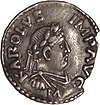 | Charles I, the Great (Charlemagne) (742–814) | 25 December 800 | 28 January 814 |
| |
 | Louis I, the Pious (778–840) | 11 September 813[8] | 20 June 840 | Son of Charles I |
|
 | Lothair I (795–855) | 5 April 823 | 29 September 855 | Son of Louis I |
|
 | Louis II (825–875) | 29 September 855 | 12 August 875 | Son of Lothair I |
|
 | Charles II, the Bald (823–877) | 29 December 875 | 6 October 877 | Son of Louis I |
|
 | Charles III, the Fat (839–888) | 12 February 881 | 13 January 888 | Grandson of Louis I |
|
Widonid dynasty
| Name | Reign | Relationship with predecessor(s) | Other title(s) | ||
|---|---|---|---|---|---|
 | Guy I (?–894) | 891 | 12 December 894 | Great-great grandson of Charles I |
|
Lambert I (880–898) | 30 April 892 | 15 October 898 | Son of Guy I |
| |
Carolingian dynasty
| Name | Reign | Relationship with predecessor(s) | Other title(s) | ||
|---|---|---|---|---|---|
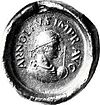 | Arnulph (850–899) | 22 February 896 | 8 December 899 | Nephew of Charles III |
|
Bosonid dynasty
| Name | Reign | Relationship with predecessor(s) | Other title(s) | ||
|---|---|---|---|---|---|
Louis III, the Blind (880–928) | 22 February 901 | 21 July 905 | Grandson of Louis II |
| |
Unruoching dynasty
| Name | Reign | Relationship with predecessor(s) | Other title(s) | ||
|---|---|---|---|---|---|
 | Berengar I (845–924) | December 915 | 7 April 924 | Grandson of Louis I |
|
Holy Roman Emperors
There was no emperor in the west between 924 and 962.
While earlier Germanic and Italian monarchs had been crowned as Roman Emperors, the actual Holy Roman Empire is usually considered to have begun with the crowning of the Saxon king Otto I. It was officially an elective position, though at times it ran in families, notably the four generations of the Salian dynasty in the 11th century. From the end of the Salian dynasty through the middle 15th century, the Emperors drew from many different German dynasties, and it was rare for the throne to pass from father to son. That changed with the ascension of the Austrian House of Habsburg, as an unbroken line of Habsburgs would hold the Imperial throne until the 18th century, later a cadet branch known as the House of Habsburg-Lorraine would likewise pass it from father to son until the abolition of the Empire in 1806. Notably, the Habsburgs also dispensed with the requirement that emperors be crowned by the pope before exercising their office. Starting with Ferdinand I, all successive Emperors forwent the traditional coronation.
Ottonian dynasty
| Image | Name | Reign | Relationship with predecessor(s) | Other title(s) | |
|---|---|---|---|---|---|
 | Otto I, the Great (912–973) | 2 February 962 | 7 May 973 | Great-great-great grandson of Louis I |
|
 | Otto II, the Red (955–983) | 25 December 967 | 7 December 983 | Son of Otto I |
|
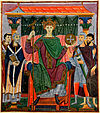 | Otto III (980–1002) | 21 May 996 | 23 January 1002 | Son of Otto II |
|
 | Henry II[9] (973–1024) | 14 February 1014 | July 13 1024 | Second cousin of Otto III |
|
Salian dynasty
| Portrait | Name | Reign | Relationship with predecessor(s) | Other title(s) | |
|---|---|---|---|---|---|
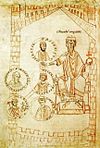 | Conrad II, the Elder[10] (990–1039) | 26 March 1027 | 4 June 1039 | Great-great-grandson of Otto I |
|
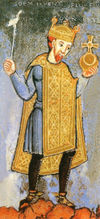 | Henry III, the Black (1017–1056) | 25 December 1046 | 5 October 1056 | Son of Conrad II |
|
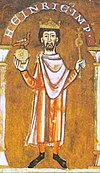 | Henry IV (1050–1116) | 5 October 1056 | 7 August 1106 | Son of Henry III |
|
 | Henry V[11] (1086–1125) | 13 April 1111 | 23 May 1125 | Son of Henry IV |
|
Supplinburg dynasty
| Portrait | Name | Reign | Relationship with predecessor(s) | Other title(s) | |
|---|---|---|---|---|---|
 | Lothair II[12] (1075–1137) | 4 June 1133 | 4 December 1137 | Great-great-great-great-great-great-grandnephew of Otto I |
|
Staufen dynasty
| Portrait | Name | Reign | Relationship with predecessor(s) | Other title(s) | |
|---|---|---|---|---|---|
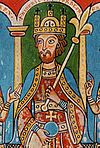 | Frederick I Barbarossa (1122–1190) | 8 June 1155 | 10 June 1190 | Great-grandson of Henry IV |
|
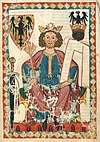 | Henry VI (1165–1197) | 14 April 1191 | 28 September 1197 | Son of Frederick I |
|
Welf dynasty
| Portrait | Name | Reign | Relationship with predecessor(s) | Other title(s) | |
|---|---|---|---|---|---|
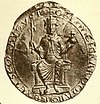 | Otto IV (1175–1218) | 9 June 1198 | 1215 | Great-grandson of Lothair II |
|
Staufen dynasty
| Portrait | Coat of arms | Name | Reign | Relationship with predecessor(s) | Other title(s) | ||||
|---|---|---|---|---|---|---|---|---|---|
 |
| Frederick II, Stupor Mundi (1194–1250) | 22 November 1220 | 13 December 1250 | Son of Henry VI |
| |||
The interregnum of the Holy Roman Empire is taken to have lasted from the deposition of Frederick II by Pope Innocent IV (1245, alternatively from the death of Frederick 1250 or the death of Conrad IV 1254) to the election of Rudolf I of Germany (1273).
Rudolf was not crowned emperor, nor were his successors Adolf and Albert.
The next emperor was Henry VII, crowned on 29 June 1312 by Pope Clement V.
House of Luxembourg
| Portrait | Coat of arms | Name | Reign | Relationship with predecessor(s) | Other title(s) | ||||
|---|---|---|---|---|---|---|---|---|---|
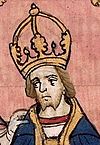 |
| Henry VII (1274-1313) | 29 June 1312 | 24 August 1313 | Great x11 grandson of Charles II |
| |||
House of Wittelsbach
| Portrait | Coat of arms | Name | Reign | Relationship with predecessor(s) | Other title(s) | ||||
|---|---|---|---|---|---|---|---|---|---|
 |
| Louis IV, the Bavarian (1282–1347) | October 1314 | 11 October 1347 | Far descendant of Henry IV and great-grandson of Lothair II |
| |||
House of Luxembourg
| Portrait | Coat of arms | Name | Reign | Relationship with predecessor(s) | Other title(s) | ||||
|---|---|---|---|---|---|---|---|---|---|
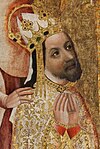 |
| Charles IV (1316–1378) | 11 July 1346 | 29 November 1378 | Grandson of Henry VII |
| |||
 |
| Sigismund (1368–1437) | 31 May 1433 | 9 December 1437 | Son of Charles IV |
| |||
House of Habsburg
| Portrait | Coat of arms | Name | Reign | Relationship with predecessor(s) | Other title(s) | |
|---|---|---|---|---|---|---|
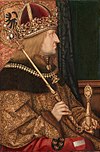 |  | Frederick III, the Peaceful (1415–1493) | 2 February 1440 | 19 August 1493 | second cousin of Albert II of Germany, Emperor designate. |
|
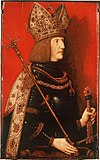 |  | Maximilian I (1459–1519) | 19 August 1493 | 12 January 1519 | Son of Frederick III |
|
 | 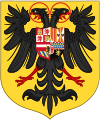 | Charles V (1500–1558) | 28 June 1519 (crowned 1530) | 16 January 1556 | Grandson of Maximilian I |
|
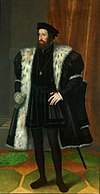 | 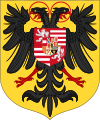 | Ferdinand I (1503–1564) | 16 January 1556 (crowned 1558) | 25 July 1564 | Brother of Charles V |
|
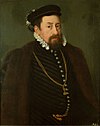 |  | Maximilian II (1527–1576) | 25 July 1564 | 12 October 1576 | Son of Ferdinand I |
|
 | 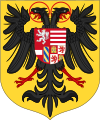 | Rudolph II[13] (1552–1612) | 12 October 1576 | 20 January 1612 | Son of Maximilian II |
|
 |  | Matthias (1557–1619) | 13 June 1612 | 20 March 1619 | Brother of Rudolf II |
|
 |  | Ferdinand II (1578–1637) | 28 August 1619 | 15 February 1637 | Cousin of Matthias |
|
 | 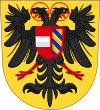 | Ferdinand III (1608–1657) | 15 February 1637 | 2 April 1657 | Son of Ferdinand II |
|
 |  | Leopold I (1640–1705) | 18 July 1658 | 5 May 1705 | Son of Ferdinand III |
|
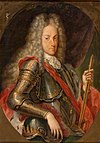 |  | Joseph I (1678–1711) | 5 May 1705 | 17 April 1711 | Son of Leopold I |
|
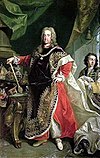 |  | Charles VI (1685–1740) | 12 October 1711 | 20 October 1740 | Brother of Joseph I | Full list
|
House of Wittelsbach
| Portrait | Coat of arms | Name | Reign | Relationship with predecessor(s) | Other title(s) | |
|---|---|---|---|---|---|---|
 |  | Charles VII (1697–1745) | 12 February 1742 | 20 January 1745 | Great-great grandson of Ferdinand II; Son-in-law of Joseph I |
|
House of Lorraine
| Portrait | Coat of arms | Name | Reign | Relationship with predecessor(s) | Other title(s) | |
|---|---|---|---|---|---|---|
 |  | Francis I (1708–1765) | 13 September 1745 | 18 August 1765 | Great-grandson of Ferdinand III; Son-in-law of Charles VI |
|
House of Habsburg-Lorraine
| Portrait | Coat of arms | Name | Reign | Relationship with predecessor(s) | Other title(s) | |
|---|---|---|---|---|---|---|
 |  | Joseph II (1741–1790) | 18 August 1765 | 20 February 1790 | Son of Empress Maria Theresa, de facto ruler of the empire, and Francis I. |
|
 |  | Leopold II (1747–1792) | 30 September 1790 | 1 March 1792 | Son of Empress Maria Theresa,de facto ruler of the empire, and Francis I. Brother of Joseph II. |
|
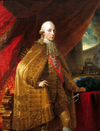 |  | Francis II (1768–1835) | 5 July 1792 | 6 August 1806 | Son of Leopold II |
|
Coronation
The Emperor was crowned in a special ceremony, traditionally performed by the Pope in Rome. Without that coronation, no king, despite exercising all powers, could call himself Emperor. In 1508, Pope Julius II allowed Maximilian I to use the title of Emperor without coronation in Rome, though the title was qualified as Electus Romanorum Imperator ("elected Emperor of the Romans"). Maximilian's successors adopted the same titulature, usually when they became the sole ruler of the Holy Roman Empire.[14] Maximilian's first successor Charles V was the last to be crowned Emperor.
| Emperor | Coronation date | Officiant | Location |
|---|---|---|---|
Charles I | 25 December 800 | Pope Leo III | Rome, Italy |
Louis I | 5 October 816 | Pope Stephen IV | Reims, France |
Lothair I | 5 April 823 | Pope Paschal I | Rome, Italy |
Louis II | 15 June 844 | Pope Leo IV | Rome, Italy |
Charles II | 29 December 875 | Pope John VIII | Rome, Italy |
Charles III | 12 February 881 | Rome, Italy | |
Guy III of Spoleto | 21 February 891 | Pope Stephen V | Rome, Italy |
Lambert II of Spoleto | 30 April 892 | Pope Formosus | Ravenna, Italy |
Arnulf of Carinthia | 22 February 896 | Rome, Italy | |
Louis III | 15 or 22 February 901 | Pope Benedict IV | Rome, Italy |
Berengar | December 915 | Pope John X | Rome, Italy |
Otto I | 2 February, 962 | Pope John XII | Rome, Italy |
Otto II | 25 December, 967 | Pope John XIII | Rome, Italy |
Otto III | 21 May, 996 | Pope Gregory V | Monza, Italy |
Henry II | 14 February 1014 | Pope Benedict VIII | Rome, Italy |
Conrad II | 26 March 1027 | Pope John XIX | Rome, Italy |
Henry III | 25 December 1046 | Pope Clement II | Rome, Italy |
Henry IV | 31 March 1084 | Antipope Clement III | Rome, Italy |
Henry V | 13 April 1111 | Pope Paschal II | Rome, Italy |
Lothair III | 4 June 1133 | Pope Innocent II | Rome, Italy |
Frederick I | 18 June 1155 | Pope Adrian IV | Rome, Italy |
Henry VI | 14 April 1191 | Pope Celestine III | Rome, Italy |
Otto IV | 4 October 1209 | Pope Innocent III | Rome, Italy |
Frederick II | 22 November 1220 | Pope Honorius III | Rome, Italy |
Henry VII | 29 June 1312 | Ghibellines cardinals | Rome, Italy |
Louis IV | 17 January 1328 | Senator Sciarra Colonna | Rome, Italy |
Charles IV | 5 April 1355 | Pope Innocent VI's cardinal | Rome, Italy |
Sigismund | 31 May 1433 | Pope Eugenius IV | Rome, Italy |
Frederick III | 19 March 1452 | Pope Nicholas V | Rome, Italy |
Charles V | 24 February 1530 | Pope Clement VII | Bologna, Italy |
See also
| Wikimedia Commons has media related to Holy Roman Emperors. |
|
- Concordat of Worms
Emperor for other uses of the title "Emperor" in Europe.- First Council of the Lateran
- Holy Roman Emperors family tree
- Holy Roman Empress
- King of the Romans
- List of German monarchs
- Holy Roman Empire
- King of Italy
- Kingdom of Italy (Holy Roman Empire)
References
^ Peter Hamish Wilson, The Holy Roman Empire, 1495–1806, MacMillan Press 1999, London, page 2
^ Erik von Kuehnelt-Leddihn: The Menace of the Herd or Procrustes at Large – Page: 164
^ Robert Edwin Herzstein, Robert Edwin Herzstein: The Holy Roman Empire in the Middle Ages: universal state or German catastrophe?
^ Peter Moraw, Heiliges Reich, in: Lexikon des Mittelalters, Munich & Zurich: Artemis 1977–1999, vol. 4, columns 2025–2028.
^ Bryce, James (1968). The Holy Roman Empire. Macmillan. p. 530..mw-parser-output cite.citation{font-style:inherit}.mw-parser-output q{quotes:"""""""'""'"}.mw-parser-output code.cs1-code{color:inherit;background:inherit;border:inherit;padding:inherit}.mw-parser-output .cs1-lock-free a{background:url("//upload.wikimedia.org/wikipedia/commons/thumb/6/65/Lock-green.svg/9px-Lock-green.svg.png")no-repeat;background-position:right .1em center}.mw-parser-output .cs1-lock-limited a,.mw-parser-output .cs1-lock-registration a{background:url("//upload.wikimedia.org/wikipedia/commons/thumb/d/d6/Lock-gray-alt-2.svg/9px-Lock-gray-alt-2.svg.png")no-repeat;background-position:right .1em center}.mw-parser-output .cs1-lock-subscription a{background:url("//upload.wikimedia.org/wikipedia/commons/thumb/a/aa/Lock-red-alt-2.svg/9px-Lock-red-alt-2.svg.png")no-repeat;background-position:right .1em center}.mw-parser-output .cs1-subscription,.mw-parser-output .cs1-registration{color:#555}.mw-parser-output .cs1-subscription span,.mw-parser-output .cs1-registration span{border-bottom:1px dotted;cursor:help}.mw-parser-output .cs1-hidden-error{display:none;font-size:100%}.mw-parser-output .cs1-visible-error{font-size:100%}.mw-parser-output .cs1-subscription,.mw-parser-output .cs1-registration,.mw-parser-output .cs1-format{font-size:95%}.mw-parser-output .cs1-kern-left,.mw-parser-output .cs1-kern-wl-left{padding-left:0.2em}.mw-parser-output .cs1-kern-right,.mw-parser-output .cs1-kern-wl-right{padding-right:0.2em}
^ The New International Encyclopædia vol. 10 (1927), p. 675
^ Carlton J. H. Hayes, A Political and Cvltvral History of Modern Europe vol. 1 (1932), p. 225.
^ Egon Boshof: Ludwig der Fromme. Darmstadt 1996, p. 89
^ Enumerated as successor of Henry I who was German King 919–936 but not Emperor.
^ Enumerated as successor of Conrad I who was German King 911–918 but not Emperor
^ Barraclough, Geoffrey (1984). The Origins of Modern Germany. W. W. Norton & Company. ISBN 0-393-30153-2.
^ Enumerated also Lothair III as successor of Lothair II, who was King of Lotharingia 855–869 but not Emperor
^ Enumerated as successor of Rudolph I who was German King 1273–1291.
^ ” Wir Franz der Zweyte, von Gottes Gnaden erwählter römischer Kaiser Imperator Austriae, Fransiscus I (1804), Allerhöchste Pragmatikal-Verordnung vom 11. August 1804, The HR Emperor, p. 1







